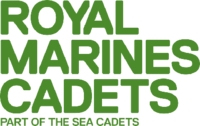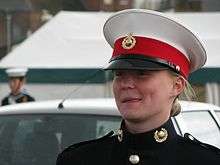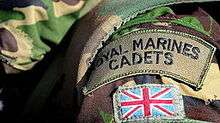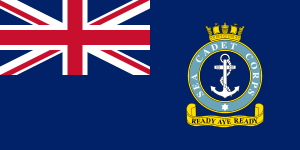Royal Marines Cadets
Royal Marines Cadets are part of the Sea Cadets, a United Kingdom uniformed youth organization. They take part in all the waterborne activities, as well as branching off into adventure training and military skills too.[3] Royal Marines Cadets specialise in activities such as orienteering, fieldcraft, and weapon handling. There are also Royal Marines Cadets of the Volunteer Cadet Corps (RMVCC; formed in 1901) and Combined Cadet Force; this article deals only with the Royal Marines Cadets of the Sea Cadet Corps.
| Royal Marines Cadets (SCC) | |
|---|---|
 | |
| Active | 1955 - Present[1] |
| Country | United Kingdom |
| Branch | Royal Navy |
| Type | National youth charity |
| Size | 3500 Cadets,[2] 127 Detachments[3] |
| Headquarters | London |
| Patron | Queen Elizabeth II |
| Website | https://www.sea-cadets.org/royal-marines-cadets |
| Commanders | |
| Captain | Captain Philip Russell MA MSc CEng CMarEng FIMarEST MRINA Royal Navy |
| UK Military Cadet Forces military component of the youth organisations in the United Kingdom |
|---|
| Components |
| British Overseas Territories |
| Former Components |
| Personnel |
| Allegiance |
History
The Royal Marines Cadets of the Sea Cadet Corps were formed in 1955 as the Marine Cadet Section, after the Commandant General Royal Marines expressed a wish to form a Marine Cadet Section which would be incorporated into the Sea Cadet Corps[1]
In 2010 the Marine Cadet Section was renamed Royal Marines Cadets, following agreement by the Queen to allow the use of "Royal" in their title. An official rebadging ceremony took place at CTCRM Lympstone on 25 September 2011.
The Royal Marines Cadets of the VCC, SCC and CCF were inspected together on parade in 2014 by the Duke of Edinburgh, in his capacity as Captain General Royal Marines to mark the 350th anniversary of the Royal Marines.[4]
In October 2019, at the National Trafalgar Day Parade, a new Corps March for the Royal Marine Cadets was first publicly performed. The March was written by the Royal Marines Band Service, and is called "Dignus" ("Be Worthy").
Organisation
Royal Marines Cadets (SCC) are a sub-branch of the Sea Cadet Corps which created in 1955 on command of the Captain General Royal Marines and the Commandant General Royal Marines to be a detachment of the sea cadet corps, similar to the structure of the Royal Marines as part of the Royal Navy. The exception is Chatham Royal Marines Cadet Unit which was established in 1903, and remains an independent unit albeit now within the SCC. The first Marine Cadet detachment was opened in Bristol Adventure unit. Marine Cadets was formed for "...sturdy, adventurous boys..." Sea Cadet units may open a Royal Marines Cadets Detachment, who will use the same facilities, parade alongside Sea Cadets and fall under the command of the units CO. Royal Marines Cadet detachments wear the uniform of the Royal Marines with the exception of Commando qualification badges,[5] and wear cadet specific insignia.[6] They follow a much more land-based training programme, with emphasis on subjects such as Weapons Handling, Mapwork and Fieldcraft.

The main differences between the Army Cadet Force and Royal Marines Cadets are:
- Uniform: The ACF is primarily only issued with MTP Uniform, whereas the RMC are issued with a number 1 uniform along with other uniforms.
- RMC cadets are also able to take part in normal SCC training, including all boating activities, providing in effect a much larger range of activities.
Cadets or adult staff wear the Royal Marines blue beret, with red tombstone patch behind the cap badge. RMC Staff who have completed either Royal Marines Commando training or the All Arms Commando Course at CTCRM Lympstone, are entitled to wear the Commando Green Beret, subject to written permission from the SRMO. Few detachments are Male only due to staffing limitations, however, the majority also take female Royal Marines Cadets. SCC detachments of Royal Marines Cadets (RMSCC) are not to be confused with the three Divisions of Royal Marines Cadets that are part of the Volunteer Cadet Corps and pre-date the RMSCC. The RMVCC is, however, part of the wider Royal Marines Cadet family alongside their SCC and CCF counterparts. As of 6 July 2014, following a tri-partite RMC parade at Buckingham Palace in the presence of the Duke of Edinburgh (Captain General Royal Marines) and in celebration of the 350th anniversary of the formation of the Royal Marines, all RM cadets from the CCF, SCC, RMVCC can be titled as Her Majesty's Royal Marines Cadets. Prior to this, the SCC used the title 'Marine cadets'.
National level
The operational head of the RMC is the Staff Royal Marines Officer (SRMO), who is a serving Royal Marines colour sergeant on secondment to the SCC. He is responsible for overseeing the running of the RMC and reporting to the CSC. He is one of the main assessors at each Company's CATSEA (Company Annual Training & Safety Efficiency Appraisal).
The SRMO is assisted by Royal Marines Cadets Senior Staff Officer (RMCSSO) and the Regimental Sergeant Major (RSM), who is the most senior warrant officer within the RMC.
Company level

Companies cover the same area as the Sea Cadet "Area", and each is identified by a phonetic letter.
- SCCHQ - Support Company
- Northern - Yankee Company
- North West - Bravo Company
- Eastern - X-Ray Company
- South West - Alpha Company
- Southern - Zulu Company
- London - Lima Company
Each company has a company commander, usually a Major (SCC) RMR, who was previously considered an ASO for Marine Cadets. In addition, Coys may include:
- Company Second in Command (2IC) - an organisation of the coy and officer development
- Company Sergeant Major (CSM)
- Company Drill Leader
- Company Medic
- Company Quartermaster - Organises Company Stores
- Company Quartermaster Sergeant (CQMS) - Assists the Quartermaster
Troop level
Since not every SCC unit has a Royal Marines Cadet Detachment, using Sea Cadet Districts would result in Troops with one detachment or none. As such, Troop borders, are independent and cross District boundaries. There are several Troops in a Company and are numbered 1 Troop, 2 Troop etc. Each troop has a Troop Commander and Troop Sergeant. The Troop Commander and Troop Sergeant organise Troop level training and are primarily responsible for the standard of the Detachments in their designated area.
Detachment level
Part of a Sea Cadet Unit. Commanded by a Detachment Commander (formerly OCMCD - Officer Commanding Marines Cadets Detachment).
Training
Gibraltar Cup Competition
The Gibraltar Cup was presented by the Commandant General Royal Marines and named from the Battle Honour of that Corps. It is awarded annually to the Royal Marines Cadet Detachment (RMCD) of the SCC which is considered to have attained the highest standard of all-round merit in the previous year.
The aim of the Gibraltar Cup Competition is for the best detachment in each Company to compete for the top award for the Royal Marines Cadets of the Sea Cadet Corps. It is held in March (annually) at the Commando Training Centre Royal Marines (CTCRM), Lympstone, Devon.
The Gibraltar Cup Competition comprises a series of challenges, tests and assessments to enable the SRMO to establish which detachment will be the worthy winners of the Gibraltar Cup. While each detachment already nominated is a worthy winner from within its own Company, only a fit, dedicated, well trained and cohesive detachment will take the trophy.
- Current Holder: Caterham Detachment (ZULU Company, Southern Area)
- Competition Date: 1-3 March
The competition was cancelled in 2018 due to heavy snowfall.
CATSEA
Company Annual Training & Safety Efficiency Appraisal (CATSEA) is established to:
- Assess the efficiency for all Detachments on a National basis, using a common standard.
- Enable the SRMO, to have a direct input to training needs based on an assessment.
- Raise standards and provide all RMCD with clear targets to aim for.
The CATSEA is conducted annually by the SRMO and the Headquarters Company Team. This CATSEA is a compulsory event for all Royal Marines Cadet Detachments. CATSEA is completed at Company (Area) level, all Detachments are assessed in the same task and the same stances are completed during the CATSEA weekend. Serving members and commissioned officers in the Royal Marine Commandos and Royal Marine Reserves, as well as commissioned officers in the SCC, complete the CATSEA assessment in regards to the Sea Cadet HQ guidelines.
Ranks
Cadets
All Royal Marines Cadets are required to complete boards for each promotion. The higher the board, the higher the level the board is run at. The former promotions from Marine Cadet to Marine Cadet 2nd Class and to Marine Cadet 1st Class were run at detachment level. Marine Cadet to Lance Corporal boards are at troop or company level, Lance Corporal to Corporal boards are at company level, and Corporal to Sergeant boards are at a national level. All promotions boards have multiple sections all of which must be passed individually.
Until November 2018 the rank of Marine Cadet First Class was granted and high-achieving Marine Cadet 1st Class could be promoted to the rank of Cadet Lance Corporal by their detachment commander. This was an honorary rank and was not needed for progression up to Cadet Corporal.
| UK Cadets |
Officers | Cadet Senior NCOs | Cadet Junior NCOs | Cadets | Recruits | |||||||
|---|---|---|---|---|---|---|---|---|---|---|---|---|
| CDT 8 | CDT 7 | CDT 6 | CDT 5 | CDT 4 | CDT 3 | CDT 2 | CDT 1 | CDT (R) | ||||
 Royal Marine Cadets (Part of the SCC) (Edit) |
No equivalent |  |
No equivalent |  |
No equivalent |  |
No insignia | No insignia | No insignia | |||
| Cadet Sergeant |
Cadet Corporal |
Cadet Lance Corporal |
Marine Cadet 1 | Marine Cadet 2 | Recruit | |||||||
| CDTSGT | CPL | L/CPL | MC1 | MC2 | MCR | |||||||
Adult senior rates / warrant officers
| Royal Marine Unit Officers (NCO's) | Rank Slide |
|---|---|
| Civilian Instructor | No Rank Slide or  |
| Probationary Sergeant |  |
| Sergeant |  |
| Colour Sergeant |  |
| Warrant Officer 2nd Class |  |
| Warrant Officer 1st Class |  |
- If an individual was previously a Petty Officer Cadet or Cadet Sergeant, they can become a Probationary Petty Officer or Sergeant, skipping the Civilian Instructor rank.
- From 2009 to 2019, if a person joined as a Civilian Instructor and wanted to be a uniformed member of staff, they would become an Acting Sergeant, following a 6 month probationary period.
Adult officers
| Marine Cadet Officers | Rank Slide |
|---|---|
| Second Lieutenant (SCC) RMR |  |
| Lieutenant (SCC) RMR |  |
| Captain (SCC) RMR |  |
| Major (SCC) RMR |  |
| Lieutenant Colonel (SCC) RMR - introduced August 2009 |  |
Investigation into sexual abuse
In 2012 payouts made to victims of sexual abuse across all Cadet Forces totaled £1,475,844. In 2013 payouts totaled £64,782, and in 2014 payouts totaled £544,213.[7]
In 2017, a BBC Panorama episode entitled "Cadet Abuse Cover-Up" highlighted sexual abuse cases in the British Cadet Forces. In a 1979 case of sexual abuse of a 14 year old cadet in Hertfordshire, the boy's parents were dissuaded from reporting the offender to police by Sea Cadet officers in full uniform, who had visited their home. The offender was neither dismissed or suspended but instead promoted to oversee 10 cadet units in London.[8] In the years 2012 to 2017 there were 28 allegations of sexual abuse made against SCC volunteers, including historical allegations. All 28 offenders were dismissed and referred to police.[8]
See also
Other Marine Cadets
Other elements of the Community Cadet Forces
Other MoD sponsored cadet forces
Related articles
References
- "About us". X-Ray Company. Retrieved 16 January 2018.
- "Welcome". Alpha Company. Retrieved 16 January 2018.
- "Royal Marines Cadets". Sea Cadets. Retrieved 16 January 2018.
- "Royal inspection for Royal Marines Cadets". Royal Navy. 9 September 2014. Retrieved 16 January 2018.
- "Sea Cadet Uniform Regulations". StudyLib. Retrieved 22 March 2019.
- "Royal Marines Cadets RMC Badges" (PDF). Alpha Company Royal Marines Cadets. May 2012. Retrieved 22 March 2019.
- Quinn, Ben (28 December 2014). "Ministry of Defence pays out £2m to settle cadets' sexual abuse claims". Guardian. Retrieved 22 January 2018.
- Razzall, Katie; MacSorley, Jane (4 July 2017). "Sex abuse was covered up at cadet forces, Panorama finds". BBC News. Retrieved 4 July 2017.